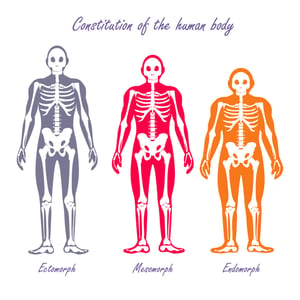Do you find yourself working out consistently and watching every bite of food, only to struggle with shedding body fat? Or perhaps you’re the opposite—able to devour full pizzas with zero visible consequences? These scenarios might seem unfair, but they can often be traced back to your natural body type. Still, body type alone doesn’t define your destiny. Fitness professionals know that body composition is influenced by far more than biology—it’s a complex fusion of habits, metabolism, environment, and training history.
In this detailed exploration, we’ll dissect the concept of body types—what they really are, why they matter (and when they don’t), and how you can use this knowledge to optimize your workouts and nutrition. Whether you're soft and rounded, lean and wiry, or muscular and athletic by nature, understanding your body's current composition is a great first step toward transforming it.
WHAT EXACTLY IS A BODY TYPE?
The term “body type,” or somatotype, originates from a mid-20th-century concept devised by Dr. W.H. Sheldon. He classified human bodies into three primary categories: endomorph, mesomorph, and ectomorph. Each of these somatotypes was believed to be fixed—unchangeable from birth—and tied to both physical and psychological attributes.

According to Sheldon:
-
Endomorphs were round and soft, prone to storing fat easily.
-
Mesomorphs were naturally muscular and strong, with rectangular builds.
-
Ectomorphs were thin, fragile, and often struggled to gain weight.
Sheldon also controversially claimed that personality was directly linked to body type—an idea that has since been thoroughly rejected by modern science. His categorization was based on the idea that people developed preferentially from one of the three embryonic layers: endoderm, mesoderm, or ectoderm, and that their physiological destiny was sealed before birth.
Though Sheldon’s belief that body type defines personality is outdated and debunked, the idea that people generally fall into certain physical categories still lingers—and not without merit.
SOMATOTYPE THEORY, RECONSIDERED
Though the psychological assumptions behind somatotype theory didn’t hold up, Sheldon’s physical observations had some staying power. Let’s take a look at the characteristics he used to define each body type:
ENDOMORPH
-
A tendency toward soft, rounded physiques.
-
A digestive system that dominates the body’s structure and function.
-
Typically associated with a calm, sociable disposition (a notion now scientifically irrelevant).
MESOMORPH
-
Prominent muscle and bone structure.
-
Solid, athletic frames.
-
Previously believed to be assertive and energetic.
ECTOMORPH
-
Long limbs, small joints, and low muscle mass.
-
High skin surface area relative to body mass.
-
Originally thought to be introverted and emotionally sensitive.
While we now know that personality has no scientific tie to body shape, these broad physical traits still loosely describe different types of physiques seen in the real world. More importantly, today's fitness industry interprets somatotypes as flexible and mutable—not fixed from birth.

BODY TYPES ARE FLUID, NOT FIXED
Today’s interpretation of body type focuses less on genetic absolutes and more on current-state physiology. You are not born an endomorph, ectomorph, or mesomorph—you may simply reflect characteristics of one or more types at any given time based on lifestyle, environment, genetics, and dietary habits.
Rather than rigid categories, think of body types as reference points on a spectrum. Most people don’t fit cleanly into a single category. In fact, our bodies can shift between these profiles throughout our lives. Your current body composition reflects not just your biology but your sleep habits, stress levels, activity patterns, and nutritional decisions.
That means no one is “stuck” as one type forever. The idea that body type is destiny? That’s a myth. And if that were true, the personal training profession wouldn’t exist
THE BODY TYPE CONTINUUM
The modern understanding of somatotypes suggests that we each display a combination of traits from the three classic categories. While some individuals may appear to fit one archetype more than others, the truth is that we all land somewhere along a sliding scale. Life events—like athletic training, injury recovery, diet changes, or even stress—can nudge you one way or the other over time.
This is why elite athletes across different sports often appear to share similar body traits. It’s not that they were born that way; it’s the result of years of targeted conditioning and training that has adapted their bodies toward a certain build.
YOUR BODY TYPE IS A STARTING POINT—NOT A LIFE SENTENCE
The key takeaway is this: while your body may currently display traits of a specific type, you are not bound to it. Your current physique is a snapshot of the choices, circumstances, and habits accumulated to date—not your fate.
Someone who trains intelligently, eats with intention, and manages their recovery well can radically change their body composition over time. Conversely, someone with genetically favorable traits who lives an inactive lifestyle can see their once-athletic physique erode.
This fluidity makes body types a useful lens for coaching—but only as a guideline. For fitness professionals, identifying a client’s most prominent traits helps tailor workouts and nutritional strategies for more effective progress. Let’s explore how.

HOW TO IDENTIFY YOUR BODY TYPE
To better understand what approach will work best for you (or a client), it helps to identify the dominant body type traits present right now:
ENDOMORPHIC TRAITS
-
Wider waist and hip measurements; higher fat storage.
-
Gains fat quickly and loses it slowly.
-
May have a sluggish metabolism or metabolic conditions (e.g., insulin resistance).
-
Often experiences low energy and sluggish recovery.
MESOMORPHIC TRAITS
-
Naturally muscular, with broader shoulders and narrower waists.
-
Can build and shed muscle or fat with relative ease.
-
Often responds quickly to resistance training.
-
Adaptable metabolism and solid recovery.
ECTOMORPHIC TRAITS
-
Long limbs and narrow frames.
-
Struggles to build muscle and gain weight.
-
Often burns through energy quickly.
-
May require higher caloric intake just to maintain mass.
Once identified, your current type can help guide training priorities and nutritional strategy—but it’s crucial to treat these as starting points, not restrictions. In the sections ahead, we’ll break down exactly how to train and eat for each body type to shift toward your ideal physique.

HOW TO TRAIN AND DIET IF YOU’RE AN ENDOMORPH
Endomorphs often struggle with excess fat storage and sluggish metabolism. To combat this, the primary goal is to increase overall energy expenditure and metabolic efficiency.
Training tips for endomorphs:
-
Emphasize high-intensity interval training (HIIT), metabolic circuits, and steady-state cardio.
-
Keep rest periods short and workouts dynamic.
-
Incorporate full-body strength training to preserve muscle mass while burning fat.
-
Increase daily movement through lifestyle habits (e.g., walking more, reducing sitting time).
Nutritional guidelines:
-
Prioritize high-protein intake to preserve muscle during fat loss.
-
Create a moderate caloric deficit to encourage fat burn.
-
Experiment with carb cycling or low-carb diets if tolerated.
-
Ensure fiber-rich, nutrient-dense foods make up the bulk of meals.
HOW TO TRAIN AND DIET IF YOU’RE AN ECTOMORPH
Ectomorphs face the challenge of gaining both muscle and strength due to naturally fast metabolisms and low fat storage. For them, the key is intensity without excess energy expenditure.
Training tips for ectomorphs:
-
Focus on hypertrophy and strength training with longer rest periods.
-
Limit cardio and energy-draining endurance training.
-
Stick to compound lifts like squats, deadlifts, and presses.
-
Avoid overtraining and prioritize recovery.
Nutritional guidelines:
-
Eat frequent, calorie-dense meals.
-
Aim for a positive energy balance with high-quality protein, carbs, and fats.
-
Include mass gainers or high-calorie shakes if needed.
-
Space protein evenly throughout the day to optimize muscle protein synthesis.
HOW TO TRAIN AND DIET IF YOU’RE A MESOMORPH
Mesomorphs typically have a naturally athletic frame and respond well to most types of training. This gives them flexibility—but not a free pass.
Training tips for mesomorphs:
-
Use a mix of strength, hypertrophy, and functional power training.
-
Incorporate sport-specific drills if desired.
-
Prioritize progression and skill mastery to avoid plateaus.
Nutritional guidelines:
-
Align macronutrient intake with training intensity and goals.
-
Increase or decrease calories based on whether the goal is fat loss or muscle gain.
-
Balance carbs and fats, with protein intake anywhere from 1.2 to 2.2 g/kg depending on training load.

ADAPTING OVER TIME: SHIFTING YOUR BODY TYPE
What’s most encouraging about all this is the knowledge that change is possible. Your current body type is not a lifelong sentence—it’s a reflection of your present physiology. If you’ve lived most of your adult life identifying as an endomorph, with effort, you can gradually take on more mesomorphic characteristics. Similarly, ectomorphs frustrated by a lack of visible muscle can develop significant mass with a carefully planned training and eating regimen.
Change Takes Time
The human body is highly adaptive, but it doesn’t transform overnight. Muscle takes time to build—usually around 1 to 2 pounds per month under ideal conditions—and fat loss occurs at a healthy rate of about 1 to 2 pounds per week. That means sustainable transformation takes months, not weeks. This is why consistency and patience are essential—and why many people quit too soon.
With the right strategy, support, and long-term commitment, the very traits that define your body type today can evolve. That’s the power of understanding and embracing where you are, so you can set a clear, personalized path forward.
HOW TO MAKE IT WORK FOR YOU
Here’s a brief refresher to help you align your training and nutrition to your current physique:
For Endomorphs:
-
Prioritize fat loss with metabolic conditioning and steady-state cardio.
-
Lift weights using circuit training and minimal rest.
-
Adopt a high-protein, reduced-calorie diet with moderate carbs and healthy fats.
-
Keep moving throughout the day to increase daily calorie burn.
-
Track progress and maintain realistic expectations—focus on long-term consistency.
For Ectomorphs:
-
Focus on muscle building with hypertrophy training and progressive overload.
-
Minimize cardio to avoid excess energy expenditure.
-
Use mass-gainer shakes if needed and ensure protein intake remains high.
-
Rest more and avoid overtraining.
-
Keep meals regular, calorie-dense, and nutrient-rich.
For Mesomorphs:
-
Tailor your training to match your goals—strength, performance, or physique.
-
Use structured resistance training and functional fitness approaches.
-
Maintain a balanced diet that aligns with your activity level and body composition goals.
-
Modify your caloric intake based on whether you aim to bulk, cut, or maintain.
-
Avoid complacency; even naturally fit bodies benefit from strategic training.
THE BOTTOM LINE
Your body type isn’t your fate—it’s just a snapshot of your current reality. What truly determines your future physique is how you train, how you eat, how you recover, and how consistently you apply those behaviors over time. The body is dynamic, not static. Your training and diet should be, too.
Whether you’re trying to lose fat, gain muscle, or just improve overall health, start by identifying where you’re at and using it as a reference—not a restriction. Adjust your fitness strategy with intention, track your outcomes, and most importantly, stay adaptable. Fitness is not about fitting into a box. It’s about building the body and life that supports your goals.
Related Tips for Maximizing Success:
-
Use progress photos every 4 weeks to track visual changes.
-
Take body measurements along with weight to monitor fat loss or gain more accurately.
-
Keep a food journal to stay consistent with your macronutrient goals.
-
Prioritize sleep and recovery—your body transforms during rest.
-
Consider working with a certified trainer or nutrition coach to maximize personalization.
This personalized, body-type-informed approach won’t just help you get better results—it will make your fitness journey more enjoyable, sustainable, and empowering.











